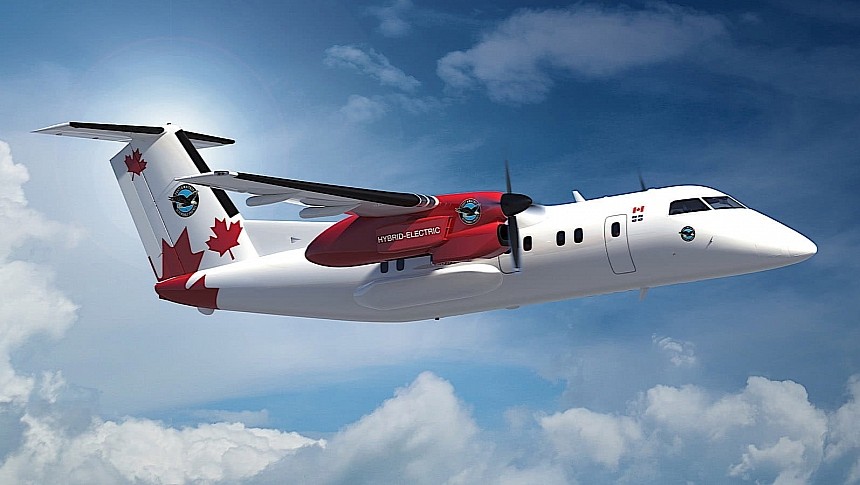The aviation industry is presently enjoying its transformative years, after decades of stagnation. For the first time in years, the industry seems committed to changing its ways as our world is attempting to move away from fossil fuels and the harm they do to the environment.
Depending on where you look in the aviation industry you'll see different things. Some are trying to reinvent the basic aircraft engine design, others are looking to advance entirely new means of aircraft, while others are looking into new fuels and innovative means of propulsion.
For Pratt & Whitney Canada this effort translates into a hybrid-electric design that, if successful, may be 30 percent more fuel efficient than the standard regional turboprops of our time.
The idea has been around for a while, and bit by bit it seems to be progressing toward a first test flight. Less than two years ago, for instance, we learned of the project getting a megawatt-class electric motor. Now we learn of a brand new bidirectional mobile charging unit (MCU) for the test plane.
The test plane would be a converted De Havilland Dash 8-100, one of the most popular turboprop aircraft for regional routes. The thing is usually powered by a pair of Pratt & Whitney engines that deliver 2,150 hp each. They allow the plane to travel at speeds of 333 mph (536 kph) and at altitudes of up to 25,000 feet (7,600 meters).
For the hybrid-electric experiment a one-megawatt electric motor will be installed in the plane. It will not replace, but complement the ICE engines, which on their own are capable of generating an extra one megawatt of power.
Additionally, a battery system supplied by H55 will be on deck to store power and distribute it where it's needed, when it's needed. And this week's news on the project is connected to these batteries.
To make sure the plane has all the juice it needs for its travels, the battery system will be fed electricity (but also drained of it when power needs to be fed into the plane's system) through a bidirectional mobile charging unit.
The MCU, which was made using commercially available components, has been designed in such a way as to deliver 280 kW and 1,500 volts, which is the standard the aviation industry is targeting for high-voltage power applications.
Pratt & Whitney is now moving to pair the MCU with the plane's battery system as the plane is in the process of conducting ground tests. Flight tests of the plane are expected to take place by the end of the year over Montreal, Canada.
There is no estimate as to when the hybrid-electric De Havilland Dash will be ready to fly commercially.
For Pratt & Whitney Canada this effort translates into a hybrid-electric design that, if successful, may be 30 percent more fuel efficient than the standard regional turboprops of our time.
The idea has been around for a while, and bit by bit it seems to be progressing toward a first test flight. Less than two years ago, for instance, we learned of the project getting a megawatt-class electric motor. Now we learn of a brand new bidirectional mobile charging unit (MCU) for the test plane.
The test plane would be a converted De Havilland Dash 8-100, one of the most popular turboprop aircraft for regional routes. The thing is usually powered by a pair of Pratt & Whitney engines that deliver 2,150 hp each. They allow the plane to travel at speeds of 333 mph (536 kph) and at altitudes of up to 25,000 feet (7,600 meters).
For the hybrid-electric experiment a one-megawatt electric motor will be installed in the plane. It will not replace, but complement the ICE engines, which on their own are capable of generating an extra one megawatt of power.
Additionally, a battery system supplied by H55 will be on deck to store power and distribute it where it's needed, when it's needed. And this week's news on the project is connected to these batteries.
To make sure the plane has all the juice it needs for its travels, the battery system will be fed electricity (but also drained of it when power needs to be fed into the plane's system) through a bidirectional mobile charging unit.
The MCU, which was made using commercially available components, has been designed in such a way as to deliver 280 kW and 1,500 volts, which is the standard the aviation industry is targeting for high-voltage power applications.
Pratt & Whitney is now moving to pair the MCU with the plane's battery system as the plane is in the process of conducting ground tests. Flight tests of the plane are expected to take place by the end of the year over Montreal, Canada.
There is no estimate as to when the hybrid-electric De Havilland Dash will be ready to fly commercially.







